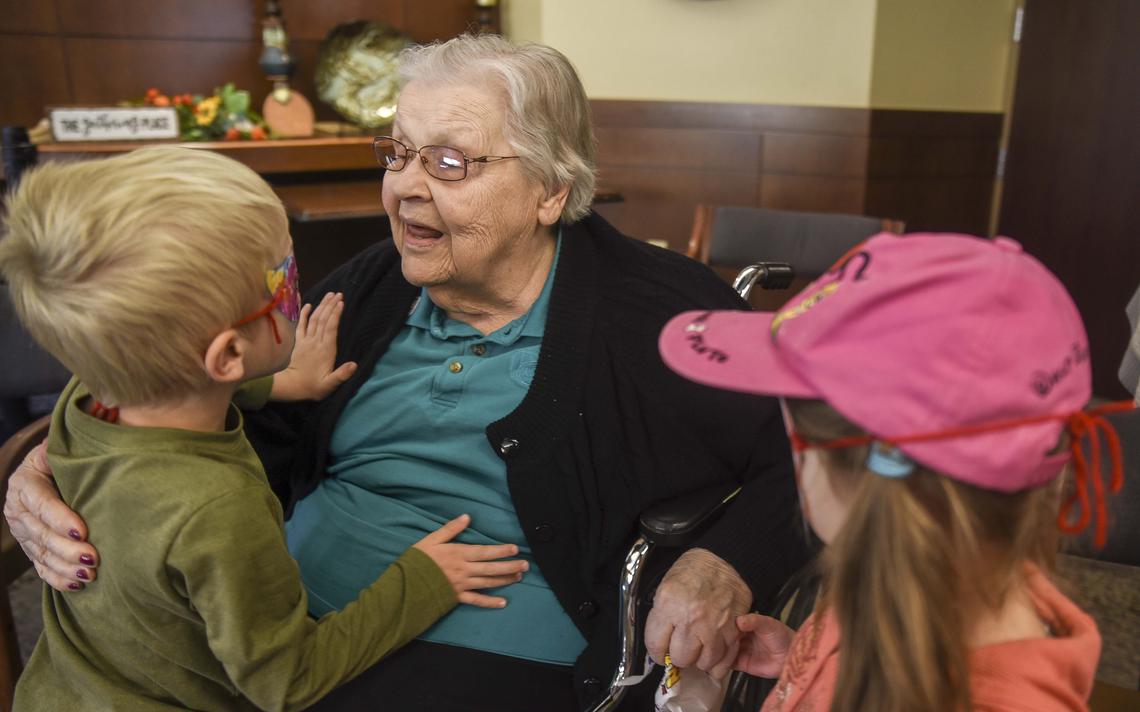WILLMAR—Dorothy Benson wore a big smile as she rolled her wheelchair out of the community room at the Carris Health Rice Care Center.
“That was a lot of fun,” she beamed.
She and a handful of other elderly residents had just spent the morning with a roomful of preschoolers from Loving Arms Childcare, pretending they were at a Renaissance fair and enjoying snacks and music.
The intergenerational program between the Rice Care Center and the day care center brings together the very old and the very young for companionship, fun and connections that span the circle of life.
“It’s such a benefit to both age groups,” said Chris Stark, director of Loving Arms.
In the two years since the program was launched, she has seen her day care children open up to the nursing home residents they meet each week. “You see hugs,” she said. “They look forward to their Monday morning visit.”
And nursing home staff see residents light up when children are in their midst. It reduces isolation and promotes feelings of purpose and connectedness, said Andrea Limoges, activity mentor at Carris Health Rice Care Center.
“We wanted to make sure our residents were getting a family feeling. What makes families complete is children,” she said.
Intergenerational programming can be found in a variety of settings worldwide, from workplace programs that provide mentorships between junior employees and experienced workers to informal community projects such as gardening. But the concept has gained its strongest foothold in settings that connect aging adults and young children.
Studies have uncovered numerous benefits: improved physical and mental well-being, improved quality of life, an enhanced sense of purpose, opportunities to learn new skills, increased empathy and reduction of stereotypes about both aging and youth.
Before joining Loving Arms, Stark was director of a child care center at a nursing home in Springfield. The positive daily interaction between old and young sold her on the importance of intergenerational connection, she said. “I kept thinking, if only I could box this and sell it.”
Soon after coming to Willmar, she started looking at how to launch a similar program at Loving Arms. Carris Health came forward as a partner and the two organizations successfully applied for a grant from the Idea Fund of Healthy Together Willmar to get the project off the ground.
“She took hold of it and it just started to morph from there,” said Amber Silva, wellness coordinator at Carris Health.
The hour-long sessions every Monday morning go by quickly. Children and elders do art projects together. They sing songs and tell stories. During the summer they plant and maintain a shared garden and harvest vegetables together. They’ve made their own butter. Right now their activities are focused on Halloween.
“That’s the unique part. The things that the kids like to do are the same things the residents like to do,” Limoges said.
There are regular field trips to attractions such as the Children’s Museum and Robbins Island Regional Park, Silva said. “We want them to have an impact here at Rice Care Center but we want them to have an impact on the community as well.”
Nursing home staff note that the program has helped the residents increase their physical activity and social interaction. For some residents, depression scores have come down substantially.
One resident almost always waits near the door to watch the children arrive, Stark said. “He told me one day, ‘You don’t know what joy that brings to my heart.'”
The benefits go both ways. Many of the children don’t have grandparents who live close by and the visits to Rice Care Center can help fill this gap, Stark said. It’s also an important way for them to become comfortable around older adults and the visible signs of aging such as walkers and wheelchairs, she said. “It erases their fear.”
The program helps children gain empathy as well, she said. “Part of bringing them here teaches that responsibility we need to have to respect our elders. We really work on making sure there is respect.”
There could also be a long-term payoff by fostering early interest in future careers in services for older adults, Limoges said. “We’re really hoping this program makes an impression on people who want to do this work.”
Program leaders were invited this past spring to give a presentation for LeadingAge Minnesota, the state’s largest association of organizations that serve older adults.
Going forward, the hope is to expand the intergenerational program to two days a week, Silva said. Funding remains a challenge but work is underway to build the expenses into annual budgets to keep the program sustainable, she said.
“It’s all about working together to make things happen,” she said. “It’s been a fun collaboration. When you talk about this program with people in the community, you see a smile on their face.”
West Central Tribune by Anne Polta


